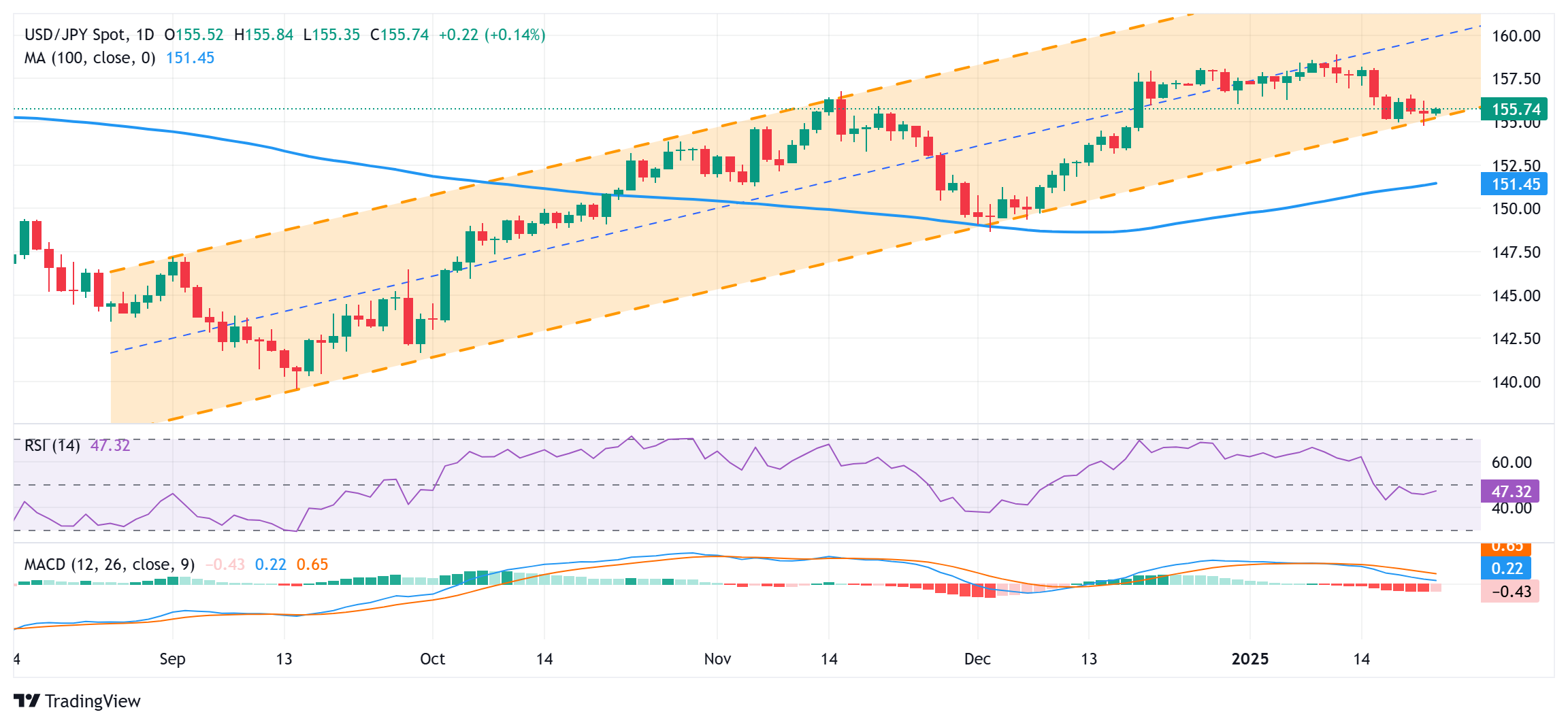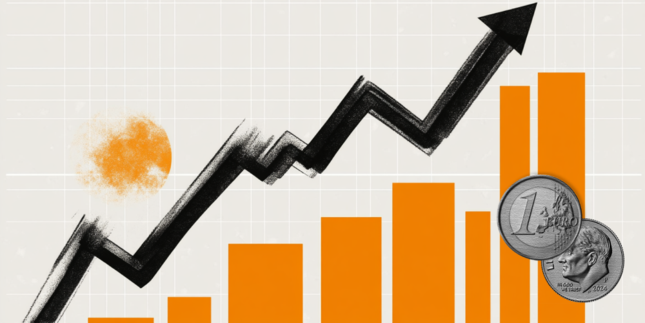Japanese Yen remains depressed amid risk-on mood, downside seems limited
- The Japanese Yen moved away from a one-month top against the USD touched on Tuesday.
- The divergent BoJ-Fed policy expectations should help limit any meaningful JPY downfall.
- Traders might also opt to move to the sidelines ahead of the BoJ meeting starting Thursday.
The Japanese Yen (JPY) sticks to its negative bias heading into the European session on Wednesday, though the downside seems limited amid expectations that the Bank of Japan (BoJ) will hike interest rates later this week. This marks a big divergence in comparison to bets that the Federal Reserve (Fed) would cut interest rates twice this year. This, in turn, caps the USD/JPY pair's recovery from over a one-month near the 156.00 round-figure mark.
Traders also seem reluctant to place aggressive bets and opt to wait for the outcome of the highly-anticipated two-day BoJ policy meeting on Friday, which will play a key role in influencing the near-term trajectory of the JPY. In the meantime, The risk-on mood – as depicted by a generally positive tone around the equity markets – undermines the safe-haven JPY and acts as a tailwind for the USD/JPY pair in the absence of any relevant economic releases.
Japanese Yen remains depressed amid risk-on mood; BoJ rate hike bets limit losses
- Against the backdrop of hawkish remarks from Bank of Japan officials, optimism that rising wages will help Japan stay on track to meet the 2% inflation target sustainably supports prospects for an imminent rate hike on Friday.
- The head of Japan's largest trade union Rengo – Tomoko Yoshino – agrees with BoJ that there is wage rise momentum. The BoJ has repeatedly said that sustained, broad-based wage hikes are a prerequisite to raising short-term rates.
- According to government sources, Japanese Prime Minister Shigeru Ishiba will emphasize strong wage growth surpassing inflation as a key element of his economic revival strategy in an upcoming policy speech to parliament.
- Japan’s largest business lobby – Keidanren – and trade unions began their annual labor negotiations on Wednesday, and expectations are for another round of significant wage increases, strengthening the case for a BoJ rate hike.
- The markets are now pricing in over a 90% chance that the BoJ will raise interest rates at the end of a two-day policy meeting on January 23-24, from 0.25% to 0.5%, which would be the highest since the 2008 global financial crisis.
- US President Donald Trump told reporters on Monday that he was thinking about implementing 25% tariffs on imports from Canada and Mexico as soon as early February, and also raised the possibility of a universal tariff.
- Higher tariffs hinder economic growth and are often thought to lift inflation. Trump, however, did not outline any specific plans for tariffs. Moreover, officials said that any new taxes would be imposed in a measured way.
- Moreover, the US Producer Price Index (PPI) and the Consumer Price Index (CPI) recently pointed to signs of abating inflation, strengthening expectations for two more interest rate cuts by the Federal Reserve later this year.
- A modest bounce in the US Treasury bond yields assists the US Dollar to move away from a two-week low and the USD/JPY pair to stage recovery from the 154.75 region, or over a one-month trough touched on Tuesday.
USD/JPY needs to move beynd 156.25 hurdle to support prospects for further gains

From a technical perspective, the USD/JPY pair has been showing resilience below the 155.00 psychological mark and the lower boundary of a multi-month-old ascending channel. The subsequent move up, along with the fact that oscillators on the daily chart are yet to gain any meaningful negative traction, warrants some caution for bearish traders. Hence, it will be prudent to wait for a sustained break and acceptance below the trend-channel support before positioning for any further depreciating move. Spot prices might then accelerate the fall towards the 154.50-154.45 intermediate support en route to the 154.00 round figure, mid-153.00s and the 153.00 mark.
On the flip side, the 156.00 round figure, closely followed by the overnight swing high, around the 156.25 region, now seems to act as an immediate hurdle ahead of the weekly top, around the 156.55-156.60 area touched on Monday. Some follow-through buying has the potential to lift the USD/JPY pair towards the 157.00 mark. The momentum could extend further towards the 157.25-157.30 area en route to the 157.60 region and the 158.00 round figure. A sustained strength beyond the latter could set the stage for a move towards retesting the multi-month peak, around the 159.00 neighborhood touched on January 10.
Fed FAQs
Monetary policy in the US is shaped by the Federal Reserve (Fed). The Fed has two mandates: to achieve price stability and foster full employment. Its primary tool to achieve these goals is by adjusting interest rates. When prices are rising too quickly and inflation is above the Fed’s 2% target, it raises interest rates, increasing borrowing costs throughout the economy. This results in a stronger US Dollar (USD) as it makes the US a more attractive place for international investors to park their money. When inflation falls below 2% or the Unemployment Rate is too high, the Fed may lower interest rates to encourage borrowing, which weighs on the Greenback.
The Federal Reserve (Fed) holds eight policy meetings a year, where the Federal Open Market Committee (FOMC) assesses economic conditions and makes monetary policy decisions. The FOMC is attended by twelve Fed officials – the seven members of the Board of Governors, the president of the Federal Reserve Bank of New York, and four of the remaining eleven regional Reserve Bank presidents, who serve one-year terms on a rotating basis.
In extreme situations, the Federal Reserve may resort to a policy named Quantitative Easing (QE). QE is the process by which the Fed substantially increases the flow of credit in a stuck financial system. It is a non-standard policy measure used during crises or when inflation is extremely low. It was the Fed’s weapon of choice during the Great Financial Crisis in 2008. It involves the Fed printing more Dollars and using them to buy high grade bonds from financial institutions. QE usually weakens the US Dollar.
Quantitative tightening (QT) is the reverse process of QE, whereby the Federal Reserve stops buying bonds from financial institutions and does not reinvest the principal from the bonds it holds maturing, to purchase new bonds. It is usually positive for the value of the US Dollar.
Forex News
Keep up with the financial markets, know what's happening and what is affecting the markets with our latest market updates. Analyze market movers, trends and build your trading strategies accordingly.





















